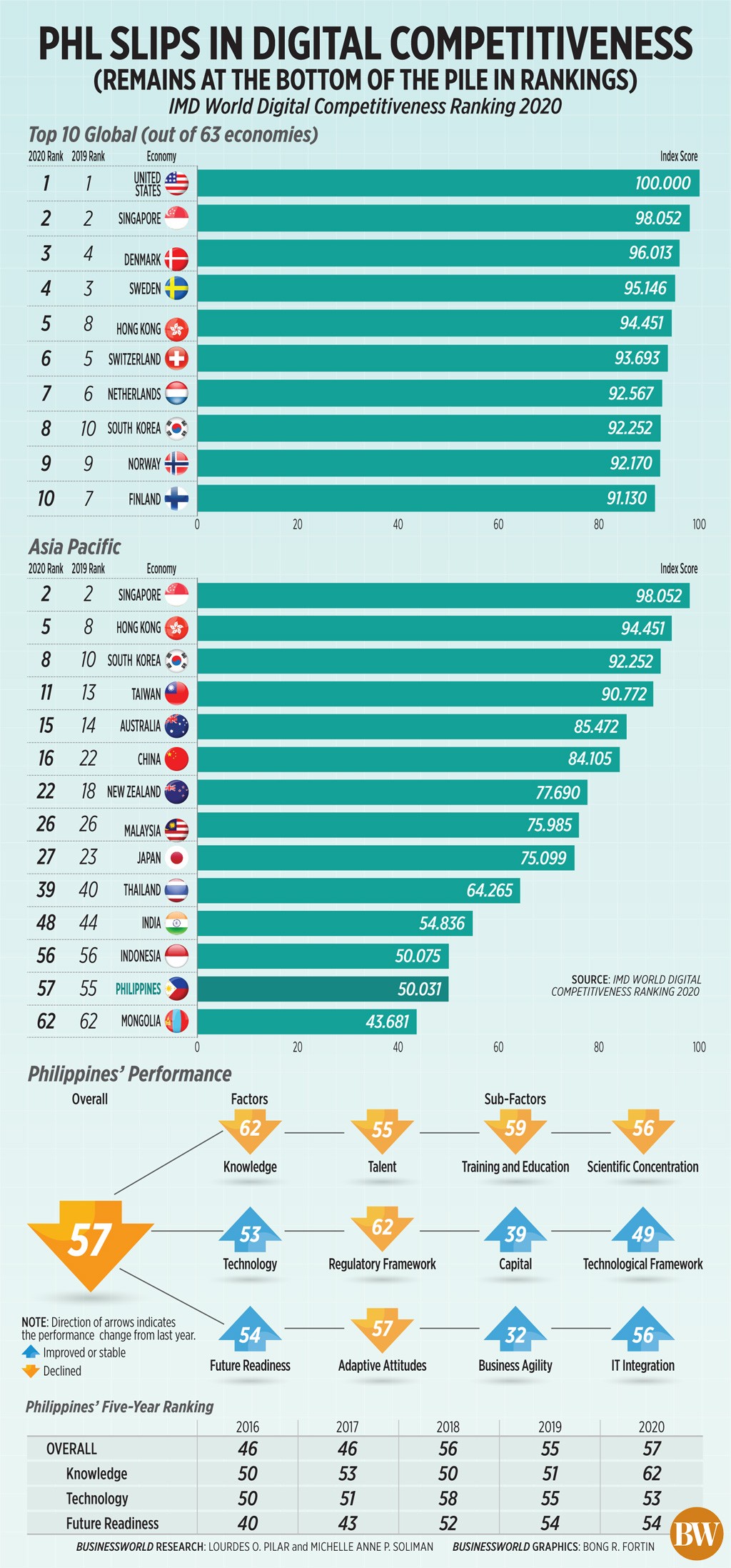
BUSINESS LEADERS are calling for improvements in information technology infrastructure and workforce talent development after the Philippine ranking for digital competitiveness dropped two spots in a global digital competitiveness index.
The Philippines placed 57th out of 63 economies in IMD business school’s World Digital Competitiveness Ranking. The country also dropped one spot to 13th place out of 14 Asia-Pacific economies after being overtaken by Indonesia.
In 2019, the Philippines edged up one spot to 55th overall, after a 10-place drop a year earlier.
Each economy is ranked in indicators grouped under three pillars. Under the knowledge pillar, the Philippines plummeted to 62nd after ranking 51st last year. Its ranking in the technology pillar improved to 53rd from 55th, while its place in the future readiness pillar stayed at 54th.
IMD Senior Economist José Caballero in an e-mail on Wednesday said the slip in the Philippines’ ranking reflects a weakening of the talent, training, and education sub-factors under the knowledge pillar.
“The deterioration of these sub-factors is mainly driven by decreases in the availability of internationally experienced senior managers, attracting foreign highly skilled personnel and employee training,” he said.
“Other countries in the Southeast Asian region perform, to different degrees, stronger in that (knowledge) factor.”
European Chamber of Commerce of the Philippines (ECCP) President Nabil Francis said the Philippines’ young and highly literate workforce attracts foreign investors looking for a competitive workforce.
“The ECCP supports measures that will promote reinforcement of skills and capability development, enact an apprenticeship reform bill, and incentivize enterprises which invest in competitive training and upskilling programs to ensure that the dividends of this demographic sweet spot are realized,” he said in a mobile message.
He also called for new laws to allow for “investments in digital technologies necessary for the online delivery of reskilling, upskilling, and training programs at a time when the current coronavirus pandemic limits physical and face-to-face interactions.”
American Chamber of Commerce of the Philippines Senior Advisor John Forbes said the proposed Digital Workforce Competitiveness Act, which would train workers with digital skills, should be passed. It is still pending at the Senate.
“It is quite important to pass this before the end of the year and prioritize its implementation to develop a large, adequately skilled workforce to support the fast-growing digital economy,” he said.
The Philippines performed its best in high tech exports, where it ranked 2nd, as well as female researchers (5th), investment in telecommunications (10th), graduates in sciences (12th), high-tech parent grants (16th), and attitude towards globalization (17th).
The Philippines performed its worst in starting a business and communications technology, ranking 62nd in both. It placed 61st in enforcing contracts and 59th in educational assessment.
The country should also improve its information technology infrastructure and develop affordable connectivity, Legislative-Executive Development Advisory Council (LEDAC) private sector representative George T. Barcelon said in a phone interview.
“It’s really slow, the availability and the speed of the broadband. Certain pockets in Metro Manila are okay, but going outside NCR, it’s really a challenge,” he said.
“As far as Filipino skill, many high-level IT experts abroad are Filipinos. They’re being poached all over… so the rating, of course, is within the shore of our archipelago. That’s the limitation,” he added.
The top 10 on the global list included the United States, Singapore, Denmark, Sweden, Hong Kong, Switzerland, the Netherlands, South Korea, Norway, and Finland.

By Jenina P. Ibañez, Reporter